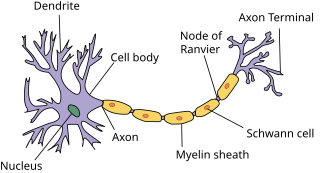electrically excitable cell that communicates via synapses From Wikipedia, the free encyclopedia
A neuron[1] (or neurone) is a nerve cell that carries electrical impulses.[2] Neurons are the basic units of our nervous system.

Neurons have a cell body (soma or cyton), dendrites and an axon.[2] Dendrites and axons are nerve fibers. There are about 86 billion neurons in the human brain. Almost all brain cells are neurons. The human brain has about 16 billion neurons in the cerebral cortex. The neurons are supported by glial cells and astrocytes.
Neurons are connected to one another, but they do not actually touch each other. Instead they have tiny gaps called synapses. These gaps are chemical synapses or electrical synapses which pass the signal from one neuron to the next.
Neuron ( link )[1]
There are three classes of neurons: motor neurons, sensory neurons and inter neurons.
Mature neurons never divide: that is the general rule. They do not undergo cell division. In most cases, neurons are generated by special types of stem cells. A type of glial cell, called astrocytes, have also been seen to turn into neurons. In humans, neurogenesis (the origin of new nerve cells) largely ceases during adulthood – but in two brain areas, the hippocampus and the olfactory bulb, there is strong evidence for substantial numbers of new neurons.[3][4].[4][5][6]
Seamless Wikipedia browsing. On steroids.
Every time you click a link to Wikipedia, Wiktionary or Wikiquote in your browser's search results, it will show the modern Wikiwand interface.
Wikiwand extension is a five stars, simple, with minimum permission required to keep your browsing private, safe and transparent.